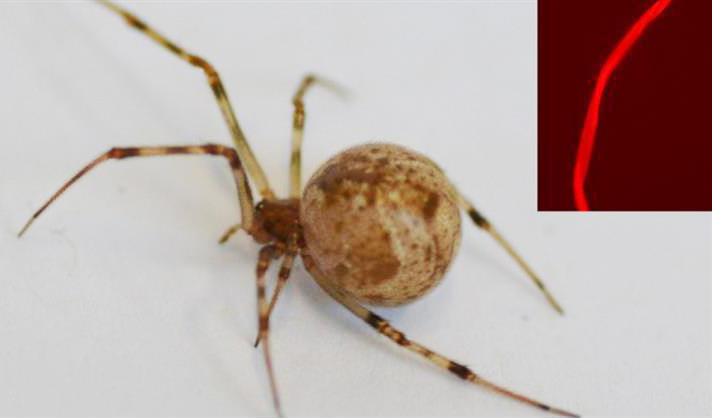
Gene Editing Spiders Produce Red Fluorescent Silk
May 14, 2025| |
A research group in the University of Bayreuth's Biomaterials research has, for the first time, successfully applied the CRISPR-Cas9 gene editing tool to spiders. Following the genetic modification, the spiders produced red fluorescent silk.
For their approach, Prof. Dr. Thomas Scheibel and his doctoral student Edgardo Santiago-Rivera developed an injection solution that included the components of the gene editing system as well as a gene sequence for a red fluorescent protein. This solution was injected into the eggs of unfertilized female spiders, which were then mated with males of the same species. As a result, the offspring of the gene-edited spiders showed red fluorescence in their dragline silk, clear evidence of the successful knock-in of the gene sequence into a silk protein.
“We have demonstrated, for the first time worldwide, that CRISPR-Cas9 can be used to incorporate a desired sequence into spider silk proteins, thereby enabling the functionalization of these silk fibers,” says Scheibel. He added that the ability to apply CRISPR gene editing to spider silk is very promising for materials science research – for example, it could be used to further increase the already high tensile strength of spider silk.
For more details, read the news release in the University of Bayreuth Press Office.
| |
You might also like:
- Silkworms Engineered for Super Silk
- CRISPR Silkworms Produce Better Silk Fibers
- Gene Editing Technique Used to Develop Spider Silk-producing Silkworm
Biotech Updates is a weekly newsletter of ISAAA, a not-for-profit organization. It is distributed for free to over 22,000 subscribers worldwide to inform them about the key developments in biosciences, especially in biotechnology. Your support will help us in our mission to feed the world with knowledge. You can help by donating as little as $10.
-
See more articles:
-
Plant
- EFSA GMO Panel Releases Scientific Opinion on GM Sugar Beet KWS20-1
- Multiplex Genome Editing Improves Agronomic Traits of Salt-tolerant Rice SR86
- [IMPORTANT UPDATE] Save the Date: 8th Asian Short Course on Agribiotechnology, Biosafety Regulation, and Communication
- Experts Discuss Barriers to Bt Cotton Adoption in the Philippines
- Ecuador Determines Cibus Herbicide Tolerance Rice Traits are Equivalent to Conventional Breeding
-
Animal
- Gene Editing Spiders Produce Red Fluorescent Silk
-
Food
- Microbiologist from São Paulo Named 2025 World Food Prize Laureate
- Kobe University Researchers Produce Healthier Yogurt Using Gene Editing
-
Read the latest: - Biotech Updates (November 12, 2025)
- Gene Editing Supplement (October 29, 2025)
- Gene Drive Supplement (February 22, 2023)
-
Subscribe to BU: - Share
- Tweet

